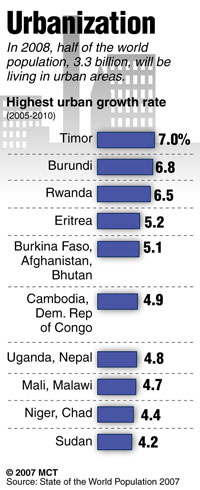World News Desk
Learn the why behind the headlines.
Subscribe to the Real Truth for FREE news and analysis.
Subscribe NowThe year 2008 will be the first time that more than half of the earth’s population—nearly 3.3 billion people—will be living in towns and cities. This worldwide rural-to-urban shift may have far-reaching negative implications for the human race.
In studying the impact that urbanization may have on the global population, a recent United Nations report revealed that as the world continues to follow an urbanization trend, it is losing the ability to sustain itself.
At the current rate of decline, the report states, by 2030 approximately 28 million people will have traded living in rural areas for a more urban setting—causing the number of urbanites in less developed regions to mushroom from 309 million in 1950 to 3.9 billion in 2030.
In addition, the report found that:
The urban populations of Africa and Asia, which have the world’s highest poverty rates, are expected to double between the years 2000 and 2030.
Half of China’s entire population will be living in cities within the next decade.
In less than 30 years, “Asia’s urban population will increase from 1.36 billion to 2.64 billion, Africa’s from 294 million to 742 million, and that of Latin America and the Caribbean from 394 million to 609 million.”
Given the projections, the report maintains that “developing countries will have 80% of the world’s urban population by 2030.”
This factor has caused alarm among authorities concerned with how to best accommodate and feed those in urban areas who are close to or fall below the poverty line, given a majority population that is not dedicated to agriculture as a source of income.
The UN report states that more than half of the urban population is below the poverty line in Angola, Armenia, Azerbaijan, Bolivia, Chad, Colombia, Georgia, Guatemala, Haiti, Madagascar, Malawi, Mozambique, Niger, Sierra Leone and Zambia.

Accompanying the UN’s concerns is the recent increase in food prices worldwide—the highest surge in over a decade.
According to a report issued by the U.S. Department of Agriculture, “Short crops around the world this year, combined with strengthening demand, are shrinking global grain stocks and causing prices to soar to the highest levels in a decade.”
The report also maintains that the decrease can be attributed to diminished levels of exportable supplies in various key markets in the Northern Hemisphere, a severe crop shortfall in Australia and strong import demand in India.
The result has caused economists and government authorities to contemplate how poor countries already struggling to sustain themselves will continue to do so in light of higher future food prices and less agricultural production.
A report by researchers of the World Bank’s Vice Presidency for Environmentally Sustainable Development revealed that 800 million people cannot afford the food necessary to maintain health.
According to Dr. Ron Wimberley, a sociology professor at North Carolina State University, crop productivity itself may not be as much of a cause for concern as government officials believe.
“Food production is less than a fifth of the population in a rural area…and many times it is a lot less than that,” he said. “By agricultural science advances we’re able to produce more by fewer people due to technologies and biotechnologies of increased production and so the number of farmers that have been required to feed us has been consistently going down.”
But he cautioned that these statistics alone do not mean rural areas are diminishing in importance. On the contrary, he maintains that it cements more tightly the survival bond between the two lifestyles.
“As long as cities exist, they will need rural resources—including the rural people and communities that help provide urban necessities,” Dr. Wimberley wrote in an editorial. “Clean air, water, food fiber, forest products and minerals all have their sources in rural areas. Cities cannot stand alone; rural natural resources can. Cities must depend on rural resources. So far, cities are getting whatever resource needs that can be had from rural areas.”
Earlier this year, Dr. Wimberley and a team of researchers from North Carolina State University and the University of Georgia collected data suggesting that humanity would pass the symbolically critical tipping point in the urban vs. rural shift this year. While new United Nations statistics place that date to be sometime in 2008, Dr. Wimberley said that this theoretical delay does not change the weight of this turning point’s implications.
He added, “But given global rural impoverishment, the rural-urban question for the future is not just what rural people and place can do for the world’s new urban majority. Rather, what can the urban majority do for poor rural people and the resources upon which cities depend for existence? The sustainable future of the new urban world may well depend upon the answer.”


